The Team Group Delta RGB SSD Review: Lite Performance, Light Drive
by Billy Tallis on September 26, 2018 8:00 AM EST- Posted in
- SSDs
- Storage
- Micron
- SATA
- Silicon Motion
- SM2258
- 3D TLC
- Team Group
- RGB LED
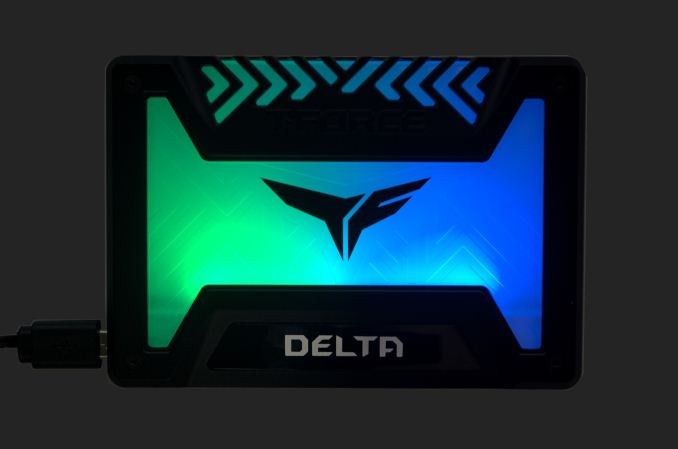
Complementing Monday's SSD review, we have another SATA SSD with customizable RGB LED lighting: Team Group's T-Force Delta RGB. Like the Kingston HyperX Fury RGB, this is a mainstream SATA drive augmented with RGB LEDs, which can be powered and controlled through a compatible motherboard header to illuminate the top of the drive case. However, the similarities between the two drives end there.
The T-Force Delta RGB SSD takes a very different approach from the HyperX Fury RGB for implementing the lighting. Where the Fury RGB put its LEDs on the back side of the SSD PCB, the Delta RGB uses a separate circuit board entirely. The top side of the drive is dominated by a textured clear plastic diffuser that is edge-lit by a single row of RGB LEDs. The T-Force Gaming logo is printed in black on this plastic piece and is silhouetted by the LED lighting, rather than being a directly illuminated logo as with the HyperX Fury RGB. Since the Delta RGB is only lit from one side there is some non-uniformity in brightness across the surface of the drive, but none of the localized variations in brightness that result from the Fury RGB's more direct backlighting. Overall the Delta RGB emits much more light than the Fury RGB despite using 8 RGB LED modules to the Fury's 75 modules.
The Delta RGB uses a digital signaling protocol for its LEDs, allowing each of the eight RGB LED modules to be controlled individually, so the drive is not limited to solid color illumination. Even though the Team Delta RGB and the HyperX Fury RGB both reuse micro-USB type B connectors for their lighting, their adapter cables are completely incompatible and require different motherboard headers. The Delta RGB's LEDs run off 5V power while the much larger array of LEDs on the Fury RGB unsurprisingly required a 12V supply.
Where the power consumption and heat generated by the LEDs on the Fury RGB seemed to be the cause of some performance problems and definitely made the drive warm to the touch, the Delta RGB's lighting solution doesn't seem to have any impact on the drive's storage functions. When a single color set of LEDs is illuminated on the Delta RGB the LEDs use a little over 0.5 W and setting the red, green and blue components all to full brightness only requires about 1.4W. By comparison, the HyperX Fury RGB requires about 2.3W for its LEDs when set to red and over 4W when everything is lit.
Team offers a few cosmetic variants of the Delta RGB. The metal case can be had with a white finish instead of the matte black our sample uses. The Delta RGB reviewed here uses a 3-pin 5V digital interface for powering and controlling the LEDs, allowing the color of each of the 8 LEDs to be set individually. Team has also announced two versions with different lighting schemes: the Delta S using a 4-pin 12V header to set a single solid color for all the LEDs, and a Delta R with an animated rainbow color effect powered (but not controlled) off a USB 2.0 header. The Delta S doesn't seem to be currently available through the usual online retailers, but the more recently announced Delta R is in stock at Newegg.
| Team Group T-Force Delta RGB SSD Specifications | |||
| Capacity | 250GB | 500GB | 1TB |
| Controller | Silicon Motion SM2258 | ||
| NAND Flash | Micron 384Gb 32L 3D TLC | ||
| Form Factor | 2.5" 9.5mm SATA | ||
| Sequential Read | 560 MB/s | 560 MB/s | 560 MB/s |
| Sequential Write | 500 MB/s | 500 MB/s | 510 MB/s |
| Random Read | 90k IOPS | 90k IOPS | 90k IOPS |
| Random Write | 80k IOPS | 80k IOPS | 85k IOPS |
| Warranty | 3 years | ||
Aside from the RGB lighting, the Delta RGB is a fairly boring SSD. It uses the very familiar Silicon Motion SM2258 controller and Micron's last-generation 32-layer 3D TLC NAND, a combination we've dealt with several times before.
Micron's first-generation 3D TLC NAND was produced in the unusual 384Gb (48GB) per die capacity. This means the Delta RGB has quite a bit more spare area to work with than a typical drive: the 250GB model has 288GB of flash. For some reason, our sample branded as a 250GB drive actually has the same usable capacity as a typical 256GB SSD. The larger models probably also offer slightly more usable capacity than they advertise, since there's plenty of raw NAND to go around even after setting aside a generous SLC write cache. However, the odd die capacity has a downside in that the flash is not optimally arranged. The 250GB Delta RGB only uses three of the four channels provided by the SM2258 controller. With a fast enough NAND interface this doesn't have to be a serious problem, but Micron's 32L 3D NAND wasn't particularly fast and we can't expect the Delta RGB to be setting any performance records.
The transition to 3D NAND brought a jump in per-die capacities, and Micron's first generation of 3D NAND went a little too far with the 384Gb TLC parts. The consequences for consumer SSDs that almost exclusively used TLC were that low-capacity drives had very few dies to access in parallel. The performance hit that causes led to most product lines abandoning the 120GB capacity class, and many SSD vendors stopped providing review samples smaller than 480GB. Since our Delta RGB sample is a 256GB drive, we only have one SATA SSD of comparable capacity using current-generation 64-layer 3D TLC to compare against, and that's the entry-level Toshiba TR200 DRAMless SSD. This review also includes several 480-512GB drives with 64L 3D NAND to compare against, but their higher capacity gives them a natural advantage for performance. The drives that are the closest to the Delta RGB in terms of performance expectations are the 256GB ADATA Ultimate SU800 and HP S700 Pro, both of which use the same SM2258 controller and Micron 32L TLC.
Since the RGB LED lighting drives the price of the Delta RGB far beyond other mainstream or low-end SATA SSDs, this review also compares the Delta RGB to some NVMe SSDs with similar pricing. The MyDigitalSSD SBX is an entry-level NVMe SSD using Toshiba 64L TLC and the Phison E8 controller. The ADATA XPG SX8200 uses the more high-end combination of Micron 64L TLC and the Silicon Motion SM2262 controller, but in the 240GB capacity is isn't quite as fast as the larger capacities that compete well against the flagship NVMe drives from Samsung and Western Digital.
The Delta RGB was put through our SSD benchmark suite with its lighting disabled, since our testbed's motherboard doesn't have RGB headers. The HyperX Fury RGB was tested with its red LEDs on at full brightness because that's its default behavior when the LED control cable is not plugged in, but the Delta RGB's LEDs are on an entirely separate circuit board from the SSD and cannot draw any power except through the LED cable. For the HyperX Fury RGB we report two sets of power measurements to reflect the total power draw including LEDs and the storage-only power draw from just the 5V supply. For the Delta RGB, we only report the power draw with the LEDs disconnected and off.
| AnandTech 2018 Consumer SSD Testbed | |
| CPU | Intel Xeon E3 1240 v5 |
| Motherboard | ASRock Fatal1ty E3V5 Performance Gaming/OC |
| Chipset | Intel C232 |
| Memory | 4x 8GB G.SKILL Ripjaws DDR4-2400 CL15 |
| Graphics | AMD Radeon HD 5450, 1920x1200@60Hz |
| Software | Windows 10 x64, version 1709 |
| Linux kernel version 4.14, fio version 3.6 | |
| Spectre/Meltdown microcode and OS patches current as of May 2018 | |
- Thanks to Intel for the Xeon E3 1240 v5 CPU
- Thanks to ASRock for the E3V5 Performance Gaming/OC
- Thanks to G.SKILL for the Ripjaws DDR4-2400 RAM
- Thanks to Corsair for the RM750 power supply, Carbide 200R case, and Hydro H60 CPU cooler
- Thanks to Quarch for the XLC Programmable Power Module and accessories
- Thanks to ICY DOCK for providing a custom ExpressCage MB324SP-B hot swap bay
- Thanks to StarTech for providing a RK2236BKF 22U rack cabinet.


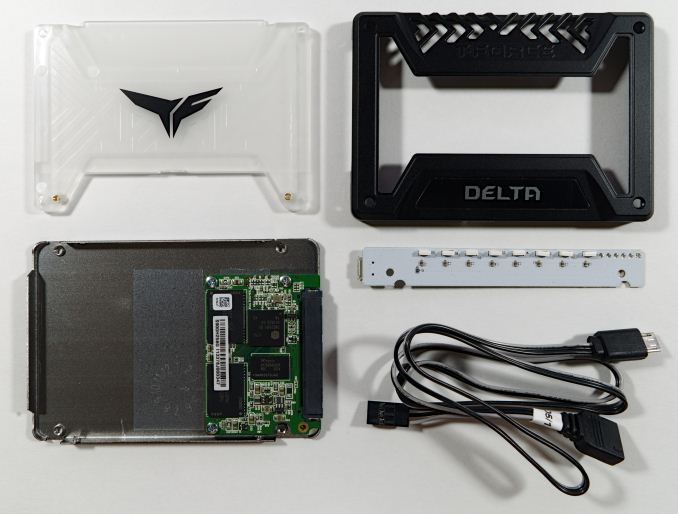
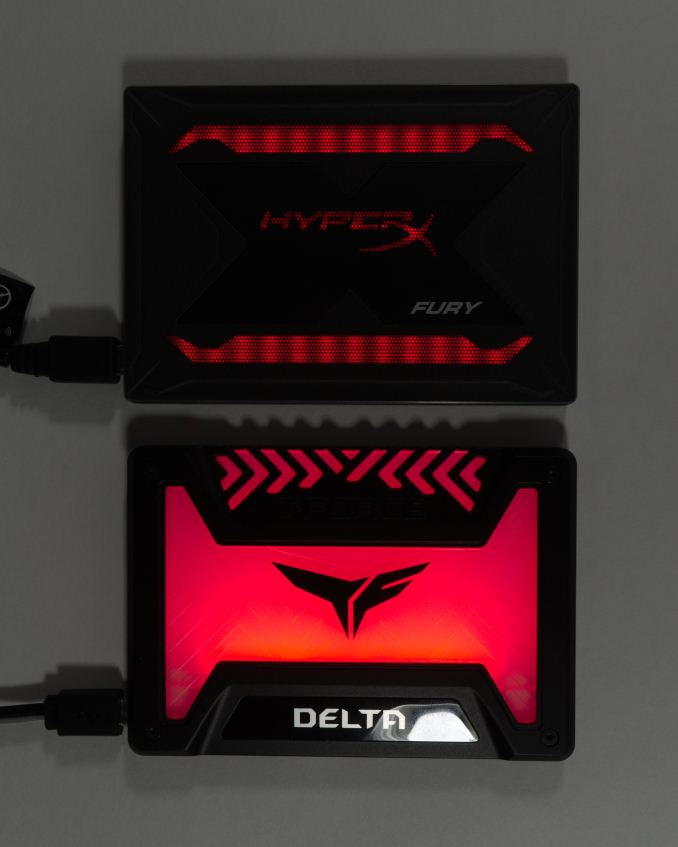
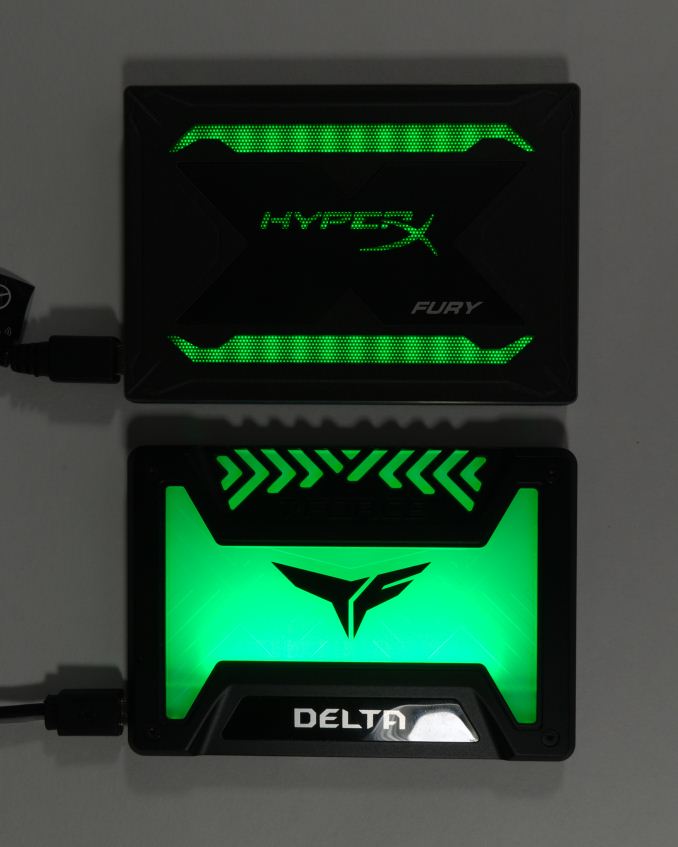
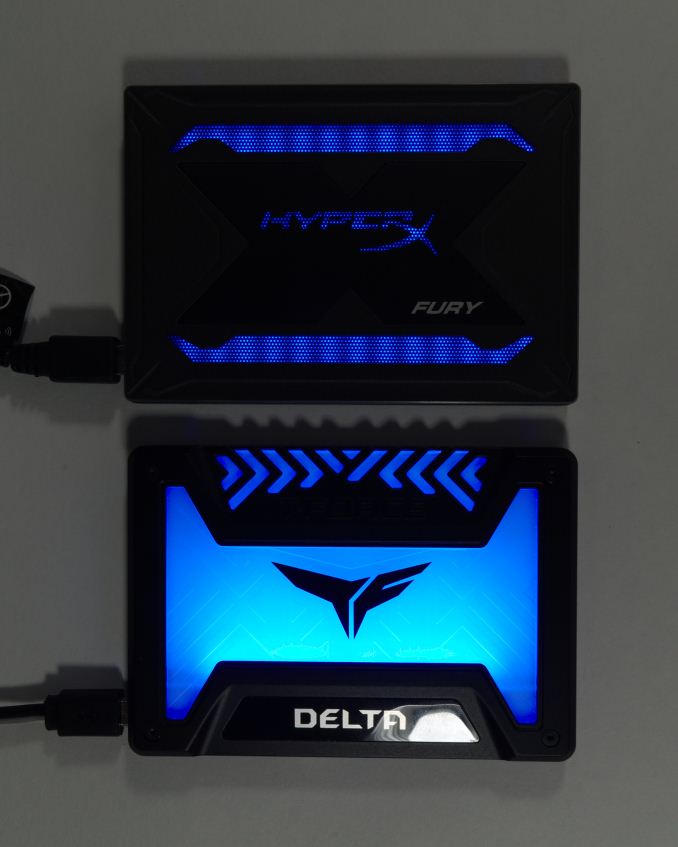














14 Comments
View All Comments
crimson117 - Wednesday, September 26, 2018 - link
What are some cases that would prominently display this SSD?Most I've seen hide the SSDs behind the motherboard tray...
rev3rsor - Wednesday, September 26, 2018 - link
Some cases, like mine (Thermaltake Core X31, I have an Intel SSD and happen to like the skull), have mounts on the power supply shroud under the motherboard. The Phanteks Evolv Shift I'm eyeing also does, from memory, it's SFF with a less conventional layout, SSD mounts around the motherboard tray.Chaitanya - Wednesday, September 26, 2018 - link
There are a tonne of cases from lots of manufacturers(Coolermaster, Nzxt, Phanteks, Fractal, etc..) which allow for the ssd to be shown off. Generally there are ssd mounting points near now removed 5.25in drive bay or on Psu shroud.The Chill Blueberry - Wednesday, September 26, 2018 - link
Deepcool BARONKASE is perfect for this! Two SSD display mount and one of those is right above an RGB water flow meter wich would look awesome! I just did a build in this case with Kingston A400 ssds and they looked very dull :/usernametaken76 - Thursday, September 27, 2018 - link
Cooler Master MasterCase H500M would be one.sonny73n - Wednesday, September 26, 2018 - link
Say this SSD has the best performance/dollar, I might get one but I’ll have to tear it apart and take out those stupid LEDs before installing it. However, it’s not worth the troubles. So to hell with the LED lightning trend.leexgx - Wednesday, September 26, 2018 - link
You could just turn them off?Ratman6161 - Wednesday, September 26, 2018 - link
i could care less about LED lighting and in fact for me, its a negative for anything that's got it, not a positive. What I care about is Price/performance. Given that, if looking for a SATA drive I see no reason to even consider anything other than the Samsung 860 Evo or the Crucial MX500. Personally I just went with the 1TB 860 Evo in M.2 format. That leaves me with my 512 GB 960 Evo as my OS drive and the 1 TB 860 EVO as a capacity driveeddman - Thursday, September 27, 2018 - link
"I do not care about LEDs, therefore I could NOT care less."milkod2001 - Wednesday, September 26, 2018 - link
When you think you saw it everywhere they put RGB on SSD drives now. Omg.